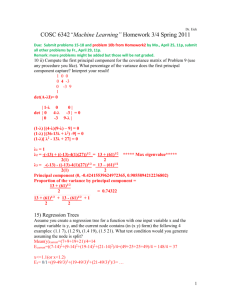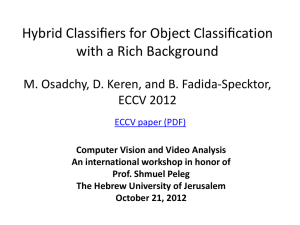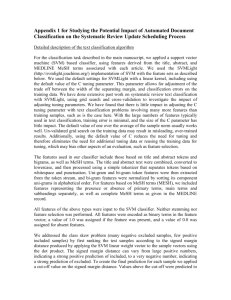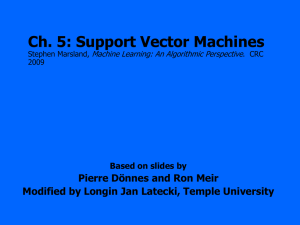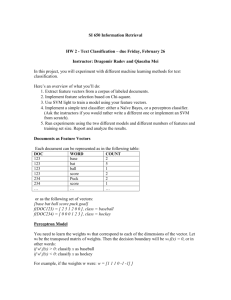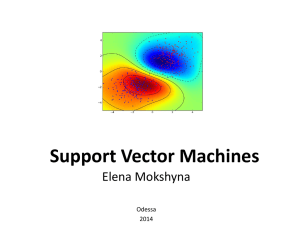Lecture 5 Support Vector Machines
advertisement
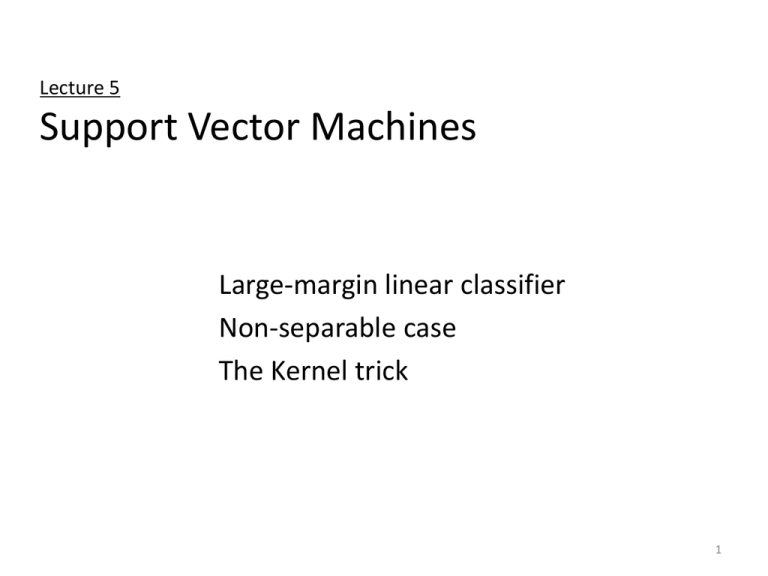
Lecture 5
Support Vector Machines
Large-margin linear classifier
Non-separable case
The Kernel trick
1
Large-margin linear classifier
Let’s assume the linearly separable case.
The optimal separating hyperplane separates the two
classes and maximizes the distance to the closest point.
•Unique solution
•Better test sample
performance
f(x)=wtx+w0
2
Large-margin linear classifier
f(x)=wtx+w0=r||w||
Large-margin linear classifier
{x1, ..., xn}: our training dataset in d-dimension
yi {1,-1}: class label
Our goal: Among all f(x) such that
Find the optimal separating hyperplane
Find the largest margin M,
Large-margin linear classifier
The border is M away from
the hyperplane. M is called
“margin”.
Drop the ||β||=1 requirement,
Let M=1 / ||β||, then the
easier version is:
Large-margin linear classifier
Non-separable case
When two classes are
not linearly separable,
allow slack variables
for the points on the
wrong side of the
border:
Non-separable case
The optimization problem becomes:
ξ=0 when the point is on the
correct side of the margin;
ξ>1 when the point passes
the hyperplane to the wrong
side;
0<ξ<1 when the point is in
the margin but still on the
correct side.
Non-separable case
When a point is outside the boundary, ξ=0. It
doesn’t play a big role in determining the
boundary ---- not forcing any special class of
distribution.
Computation
equivalent
C replaces the constant.
For separable case, C=∞.
Computation
The Lagrange function is:
Take derivatives of β, β0, ξi, set to zero:
And positivity constraints:
Computation
Substitute 12.10~12.12 into 12.9, the Lagrangian
dual objective function:
Karush-Kuhn-Tucker conditions include
Computation
From
form:
Non-zero coefficients
which
, The solution of β has the
only for those points i for
These are called “support vectors”.
Some will lie on the edge of the margin
the remainder have
,
the wrong side of the margin.
They are on
Computation
Computation
Smaller C.
85% of the
points are
support
points.
Support Vector Machines
Enlarge the feature space to make the procedure
more flexible.
Basis functions
Use the same procedure to construct SV classifier
The decision is made by
SVM
Recall in
linear space:
With new
basis:
SVM
h(x) is involved ONLY in the form of inner product!
So as long as we define the kernel function
Which computes the inner product in the
transformed space, we don’t need to know what
h(x) itself is! “Kernel trick”
Some commonly used Kernels:
SVM
Recall αi=0 for non-support vectors, f(x) depends
only on the support vectors.
SVM
SVM
K(x,x’) can be seen as a similarity measure between
x and x’.
The decision is made essentially by a weighted sum
of similarity of the object to all the support vectors.
SVM
Using kernel trick brings the feature space to very
high dimension many many parameters. Why
doesn’t the method suffer from the curse of
dimensionality or overfitting???
Vapnic argues that the number of parameters alone,
or dimensions alone, is not a true reflection of how
flexible the classifier is.
Compare two functions in 1-dimension:
f(x)=α+βx
g(x)=sin(αx)
SVM
g(x)=sin(αx) is a really flexible classifier in 1-dimension,
although it has only one parameter.
f(x)=α+βx can only promise to separate two points
every time, although it has one more parameter
?
SVM
Vapnic-Chernovenkis dimension:
The VC dimension of a class of classifiers {f(x,α)} is
defined to be the largest number of points that can
be shattered by members of {f(x,α)}
A set of points is said to be shattered by a class of
function if, no matter how the class labels are
assigned, a member of the class can separate them
perfectly.
SVM
Linear classifier is rigid. A hyperplane classifier has
VC dimension of d+1, where d is the feature
dimension.
SVM
The class sin(αx) has infinite VC dimension. By
appropriate choice of α, any number of points can be
shattered.
The VC dimension of the nearest neighbor classifier is
infinity --- you can always get perfect classification in
training data.
For many classifiers, it is difficult to compute VC dimension
exactly. But this doesn’t diminish its value for theoretical
arguments.
Th VC dimension is a measure of complexity of the class
of functions by assessing how wiggly the function can be.
SVM
Strengths of SVM:
flexibility
scales well for high-dimensional data
can control complexity and error tradeoff explicitly
as long as a kernel can be defined, nontraditional (vector) data, like strings, trees can
be input
Weakness
how to choose a good kernel?
(a low degree polynomial or radial basis
function can be a good start)



